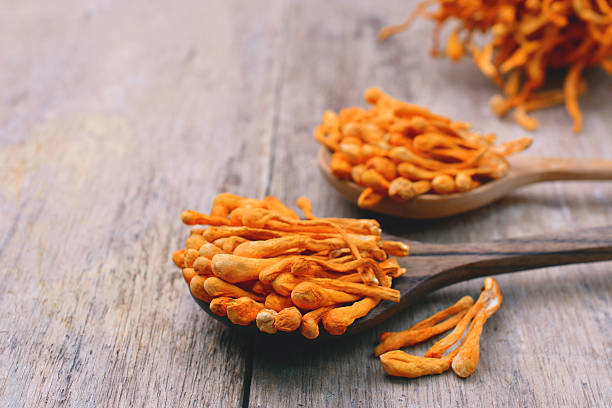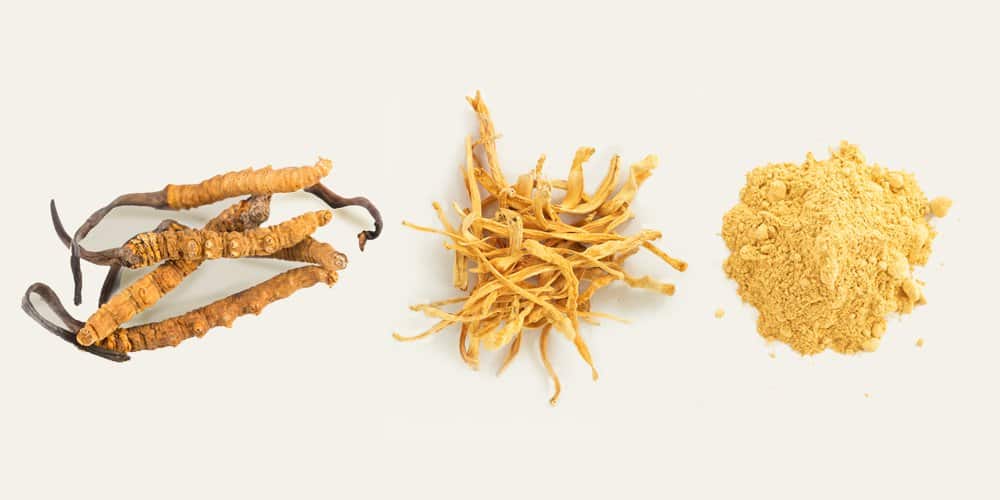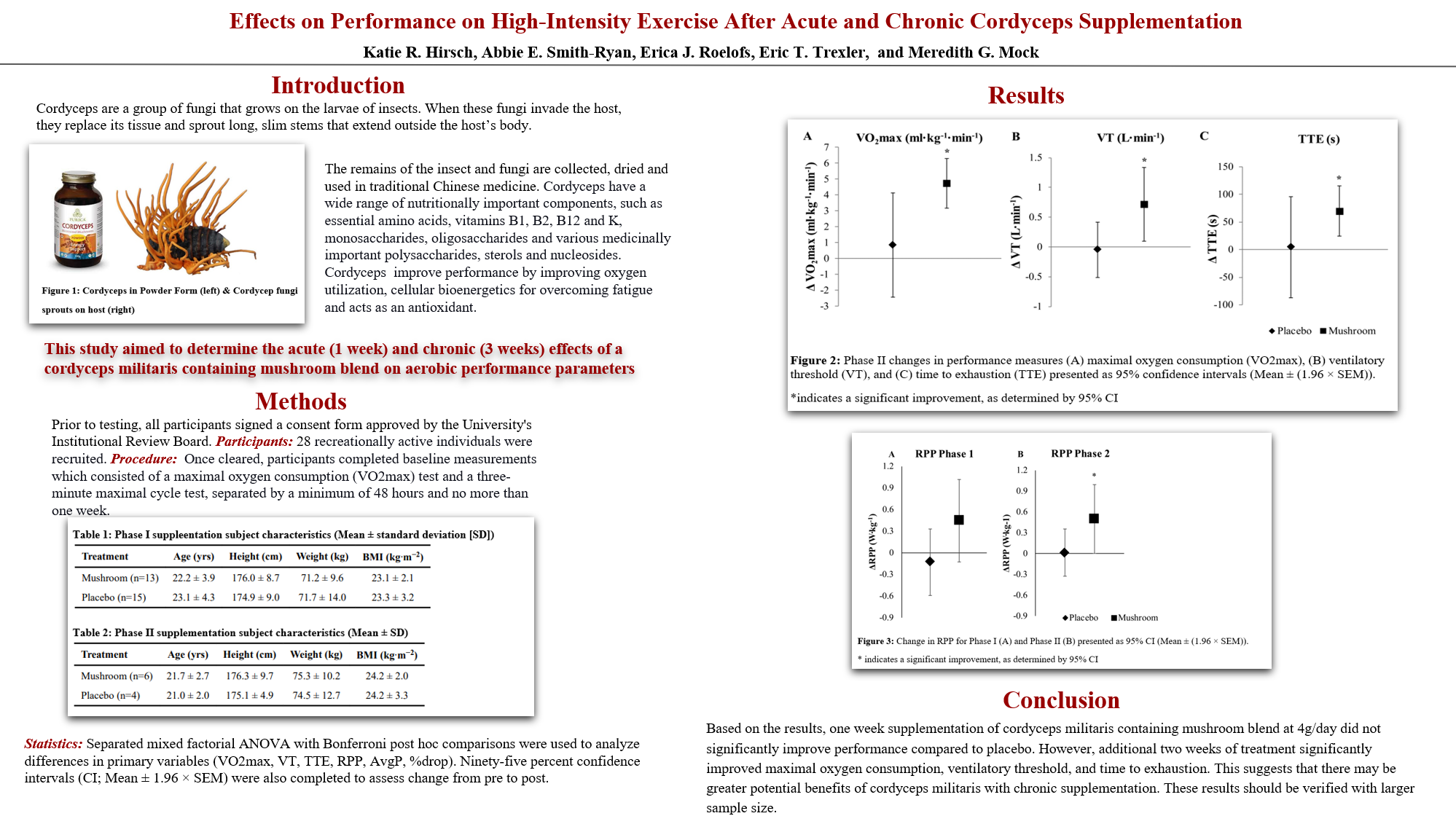Introduction
Cordyceps is a group of fungi that grows on the larvae of insects (Lin & Li, 2011). When these fungi invade the host, they replace its tissue and sprout long, slim stems that extend outside the host’s body (Lin, 2011). The remains of the insect and fungi are collected, dried, and used in traditional Chinese medicine to treat diverse conditions, including respiratory and kidney diseases, renal dysfunction, weariness, and cardiac dysfunction (Hirsch et al., 2017).
Of the 350 species of cordyceps discovered, two have become the focus of health research: Cordyceps sinensis and Cordyceps militaris (Lin & Li, 2011).
Cordyceps have a wide range of nutritionally important components, such as essential amino acids, vitamins B1, B2, B12, and K, monosaccharides, oligosaccharides, and various medicinally important polysaccharides, sterols and nucleosides (Tuli et al., 2014).
The benefits of cordyceps for athletic performance started gaining popularity after 1993. This is when record-breaking performances of Chinese female athletes were attributed to their nutritional regimen involving cordyceps supplementation (Hirsch et al., 2017). Though there was a lot of skepticism around the performance of these athletes, interest in the potential performance-enhancing effects of cordyceps remained.

Studies on cordyceps show improved performance by improving blood flow, oxygen utilization, and acting as antioxidants (Hirsch et al., 2017).
However, available studies utilizing cordyceps vary considerably in dosing and supplementation duration. Despite potential benefits, several studies have found no benefits of cordyceps supplementation on aerobic and anaerobic performance acutely (Hirsch et al., 2017). The purpose of Hirsch et al. (2017) study was to determine the acute (1 week) and chronic ( 3 weeks) effects of a cordyceps militaris containing mushroom blend on aerobic performance parameters.
Proposed Mechanism of Supplementation
Multiple mechanisms contribute to the benefits of cordyceps; not all are well understood. However, there is potential for cordyceps sinensis to reduce oxidative stress and thereby optimize cellular bioenergetics which is a possible mechanism of action in overcoming fatigue and other aging-related symptoms (Yi et al., 2004).
There are also mechanisms that affect direct immune protection, apoptosis, protein synthesis, and antioxidant and antiviral activities in cordyceps.
The apoptotic homeostasis regulated by cordyceps is the most potent mechanism.
Apoptosis removes cells during development and eliminates pre-cancerous and virus-infected cells (Lin & Li, 2011). Apoptosis essentially maintains the balance of cells in the human body, which is an essential part of our immune system (Lin & Li, 2011).
Another active compound known as cordycepin is found in cordyceps.
The mechanism of cordycepin in anti-diabetic activity is not fully understood, but one study may explain a possible pathway. Shin et al. (2009) found that cordycepin prevents the production of nitric oxide and pro-inflammatory cytokines like TNF-α, IL-1β, and IL-6 in bacterial lipopolysaccharide (LPS)-activated macrophages by inhibiting the protein expression of pro-inflammatory mediators. Due to this, the expression of type 2 diabetes-regulating genes known as 11β-HSD1 and PPARλ was reduced (Shin et al., 2009). In addition, it seems like cordycepin suppresses the expression of diabetes-regulating genes through the inactivation of NF-κb-dependent inflammatory responses (Ji et al., 2009).
In summary, the mechanisms and components in cordyceps help maintain our immune system and have anti-diabetic and anti-inflammatory responses.

Benefits, Risks, and Potential Side Effects
Cordyceps improves the production of adenosine triphosphate, which is essential for delivering energy to the muscles (Yi et al., 2004).
This improves how our body uses oxygen, especially during exercise, as seen in a randomized, double-blind control trial. The results showed a significant improvement of 7% increase in VO2 max in those who took cordyceps sinensis, whereas those with the placebo pill showed no change (Yi et al., 2004).
There is increasing evidence that cordyceps have antioxidant activity. This may be one of the mechanisms behind the anti-cancer and anti-inflammatory benefits.
Researchers believe the fungi may exert anti-tumour effects. In test-tube studies, Cordyceps hindered the growth of many cancer cells, including colon, skin, lung, and liver cancers (Bizarro et al., 2015).
Interestingly, Cordyceps also may keep blood sugar levels within a healthy range by mimicking the action of insulin.
In several diabetic mice studies, cordyceps decreased blood sugar levels by increasing insulin sensitivity (Yu et al., 2015, Lo et al., 2004). Lastly, research has shown that cordyceps suppress unique proteins that increase inflammation in the body. In fact, cordyceps supplementation reduces inflammation markers in the airways of mice, making them a potential therapy for asthma (Hsu, 2008).
Although cordyceps have many promising results, there’s little research on their effects on humans.
While cordyceps are generally safe, it may cause an upset stomach, nausea, and dry mouth (Tuli et al., 2014). Thus, we need more studies before experts can make any recommendations. At the same time, animal and lab studies indicate that cordyceps have the potential to combat inflammation, cancer, and diabetes.
However, many of these studies are of poor quality, as they may not translate into humans. Nevertheless, there are human studies examining the effects on exercise performance, and the fungi can potentially boost energy and oxygen use during exercise. However, there seems to be no consensus on the dosage people should take to see its health benefits or how safe it is.
The Study Design, Sample Characteristics, and Intervention
This was a randomized, repeated measure, double-blind, placebo-controlled study design.
Twenty-eight recreationally active individuals (Mean +/- SD; Age = 22.7 +/- 4.1 yrs; Height= 175.4 +/- 8.7 cm; Weight= 71.6 +/- 12.0 kg) were randomly assigned, using Random Allocation Software, into one of two groups: mushroom (MR) or placebo (PL) group.
Subjects had to orally ingest 1.3 grams of either mushroom blend or maltodextrin (PL) in the form of two capsules, three times per day for one week (phase 1) or three weeks (phase 2). The capsules were identical in colour, taste, and package.
Twenty-eight participants ( 16 males; 12 females) completed phase 1 and 10 subjects (4 males; 6 females) volunteered to continue receiving the supplements for an additional 2 weeks (phase 2). Prior to and one week after supplementation, participants performed an aerobic fitness and a three-minute maximal cycle test using a cycle ergometer to measure VO2 max, time to exhaustion, ventilatory threshold, peak power output, average power, and % drop.
They performed the two tests 24 hours apart. Participants who continued the supplementation performed the same tests at the end of the second and third weeks of the treatments.
Strengths and Weaknesses of the Study Design
One of the strengths associated with the study design is performing a repeated measure test. With the repeated measure test, they use and test the same participants in each condition, and this reduced the error of variance (individual differences).
The second strength is that it is a double-blind design, which prevents bias from influencing the study results. Fitness testing protocols for this study design were another strength. Participants had at least a 24-hour recovery period between the two tests which could prevent fatigue.
Although this was an experimental study, there are also weaknesses associated with the design.
The study only tested recreationally active individuals and did not consider other populations such as different elite athletes. Thus, the treatment effects might not be generalized to all athletes. Furthermore, the study only contained 28 participants for Phase 1 and was reduced to 10 for Phase 2.
The small sample size threatens the generalizability and validity of the study’s results.
Findings from Previous Literature
In a previous randomized, placebo-controlled, double-blind study, 17 competitive male cyclists were supplemented with either 1000 mg per day of cordyceps sinensis (treatment) or methylcellulose (placebo) for two weeks (Earnest et al., 2004).
After 14 days of supplementation, participants were tested on a cycle ergometer to analyze cardiorespiratory parameters. There was no significant difference in peak power, VO2 max, and time to exhaustion between the two groups after 2 weeks (Earnest et al., 2004).
In another study, 37 healthy elderly individuals were randomly assigned to receive either cordyceps sinensis (treatment) 3 g/day or identical placebo capsules. Exercise performance was tested using a cycle ergometer before and 6 weeks after treatments.
The results demonstrated that there was a significant increase in ventilatory threshold and VO2 max in the cordyceps sinensis group when compared to the control group (Yi et al., 2004).
The results of these studies may suggest that you might need longer supplementation of cordyceps to achieve greater performance change. Previous literature investigated the performance benefits of synthetically cultivated versions of Cordyceps Sinensis.
Although Cordyceps Militaris is also synthetically cultivated, it contains a more active constituent, resulting in a more noticeable performance (Hirsh et al., 2017).
Conclusion and Recommendations
Cordyceps Sinensis and Cordyceps Militaris, the two branches of Cordyceps fungi, have been tested in various studies for their potential health benefits. Acute supplementations of both cordyceps Sinensis and Militaris have shown no significant difference in cardiorespiratory parameters nor any change in exercise performance.
However, chronic supplementation has been shown to improve VO2 max, VT, time to exhaustion, and peak power output in healthy elderly and recreationally active individuals.
Regarding recommendations, there seem to be no optimal dosing strategies. One recommendation is to see if there is an acute response with a higher dose of Cordyceps. Another recommendation is testing on various populations, such as elite and non-athletic athletes, to see if they both reap the same benefit.
Lastly, larger sample size is needed for more valid and generalized results.




